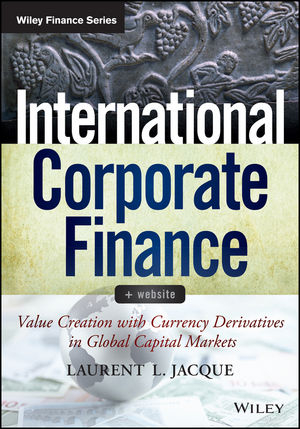
International Corporate Finance
John Wiley & Sons Inc (Verlag)
978-1-118-78186-9 (ISBN)
- Titel ist leider vergriffen;
keine Neuauflage - Artikel merken
A thorough introduction to corporate finance from a renowned professor of finance and banking As globalization redefines the field of corporate finance, international and domestic finance have become almost inseparably intertwined. It's increasingly difficult to understand what is happening in capital markets without a firm grasp of currency markets, the investment strategies of sovereign wealth funds, carry trade, and foreign exchange derivatives products. International Corporate Finance offers thorough coverage of the international monetary climate, including Islamic finance, Asian banking, and cross-border mergers and acquisitions. Additionally, the book offers keen insight on global capital markets, equity markets, and bond markets, as well as foreign exchange risk management and how to forecast exchange rates.
* Offers a comprehensive discussion of the current state of international corporate finance * Provides simple rules and pragmatic answers to key managerial questions and issues * Includes case studies and real-world decision-making situations For anyone who wants to understand how finance works in today's hyper-connected global economy, International Corporate Finance is an insightful, practical guide to this complex subject.
LAURENT L. JACQUE is the Walter B. Wriston Professor of International Finance & Banking at the Fletcher School (Tufts University). As Fletcher s Academic Dean he was responsible for the design and establishment of its Master of International Business degree program. Since 1990 he has held a secondary appointment at HEC (Paris) and was previously on the faculty of the Wharton School for eleven years. His last book, Global Derivative Debacles: From Theory to Malpractice, has been translated in French, Chinese, Russian and Korean. A recipient of several awards for outstanding teaching, he is a consultant to a number of multinational firms and financial institutions around the world. He is a graduate of HEC (Paris) and holds MA, MBA and PhD from the Wharton School.
Preface xvii Acknowledgments xxiii About the Author xxv Chapter 1 What Is International Corporate Finance? 1 The Uneven Reach of Globalization 2 The Rise of the Multinational Corporation 3 What Is Different about International Corporate Finance? 6 Risks in the Wonderland of International Finance 8 Internationalization and the Locus of the Finance Function 12 The International Control Conundrum 15 Exploiting the Multinational Enterprise System 16 Summary 18 Questions for Discussion 19 References 19 PART one The International Monetary Environment 21 Chapter 2 Exchange Rates Regimes 23 Some First Principles about Exchange Rate Determination 24 World Map of Exchange Rate Regimes: The Flexibility x Convertibility Space 29 Floating Exchange Rates 31 Stabilized or Pegged Exchange Rates 38 Controlled Exchange Rates 44 Summary 49 Appendix 2A: The Purchasing Power Parity Hypothesis 49 Questions for Discussion 58 Problems 58 References 61 Chapter 3 Yesterday and Yesteryear: A Brief History of the International Monetary System 63 Chronology of the International Monetary System 64 The Gold Standard (1878 1914, 1925 1931) 67 The Bretton Woods System (1944 1971) 69 Managed Floating Exchange Rates (1973 ) 73 European Monetary System and the European Currency Unit (1979 1999) 74 Emerging Markets Currency Regimes and Crises 78 European Monetary Union and the Birth of the Euro (1999 Present) 81 Today and Tomorrow: The Current Map of Exchange Rates 85 Summary 88 Questions for Discussion 89 Problems 90 References 92 Chapter 4 The Balance of Payments 93 Fundamentals of Balance of International Payments Accounting 94 Current Account 99 Capital Account 101 Official Reserve Account 102 Statistical Discrepancies: Errors and Omissions 103 Balance of Payments and the Foreign Exchange Market 103 Debtor versus Creditor Nations 107 Linking the Balance of Payments to National Income 109 Summary 111 Questions for Discussion 112 Problems 113 References 115 PART TWO The Foreign Exchange Market and Currency Derivatives 117 Chapter 5 The Foreign Exchange Market 119 How Forex Is Traded: The Institutional Framework 120 Foreign Exchange Products 128 Exchange Rate Quotations 131 Summary 143 Questions for Discussion 144 Problems 144 References 147 Chapter 6 Interest Rate Arbitrage and Parity 149 Interest Rate Arbitrage Theorem 150 Interest Rate Parity 158 Uncovered Interest Rate Arbitrage and the Carry Trade 166 Summary 169 Appendix 6A: Interest Rate Parity and Asymmetric Taxation 170 Appendix 6B: The Linkages between Interest, Inflation, and Exchange Rates 171 Questions for Discussion 177 Problems 177 References 183 Chapter 7 Currency Futures, Options, and Swaps 185 A Brief History of Derivatives 186 Currency Futures 190 Currency Options 195 Risk Profile of Currency Options 198 Option Strategies 200 Put-Call Parity Theorem 206 The Valuation of Currency Options 209 Derivatives and Zero-Premium Options 215 Currency Swaps 218 Interest Rate Swaps 224 Summary 226 Questions for Discussion 227 Problems 228 References 231 PART Three International Financing 233 Chapter 8 The International Financial Sector and the Dynamics of Global Capital Markets 235 Financing as a Global Procurement Decision 236 The Financial System and Financial (Dis)Intermediation 238 Securitization and the (Lower) Cost of Consumer Financing 241 Deregulation 249 Mapping the Financial System/Capital Market Emergence Process 252 Summary 259 Questions for Discussion 260 Problems 260 References 263 Chapter 9 Sourcing Equity Globally 265 A Grand Tour of Equity Markets 266 Global Equity Financing as a Procurement Decision 273 Internationalizing the Cost of Capital: The Landmark Case of Novo Industri 274 Why Do Firms Cross-List? 279 How to Source Equity Globally 281 Summary 286 Questions for Discussion 288 Problems 288 References 290 Chapter 10 Sourcing Debt from Global Bond Markets 291 The International Debt Procurement Decision 292 Grand Tour of the Global Debt Market 293 Cost of Foreign Currency Debt Financing 299 Debt Refinancing 304 The International Debt Financing Conundrum 307 Summary 309 Questions for Discussion 310 Problems 311 References 315 Chapter 11 International Trade Financing 317 A Brief History of International Trade 317 The Trilogy of Risks in Exporting 318 Managing Credit Risk 321 Managing Currency Risk 322 Managing Country Risk 323 The Mechanics of Trade Financing with a Letter of Credit 324 Financing Exports 327 Pre-Export Financing 330 Government-Sponsored Export Credit Agencies 332 Summary 333 Questions for Discussion 333 Problems 334 Chapter 12 Asian Finance and Banking 337 Asian Finance: Common Historical Roots, Diverse Paths 338 Adaptive Responses: Crises and Institutional Change in Asian Finance 342 Business Organization, Corporate Ownership, and Governance 346 Capital Market Development 356 Capital Structure and the Cost of Capital 364 Performance, Value, and the Practice of Corporate Finance 366 Summary 368 Questions for Discussion 369 References 369 Chapter 13 Islamic Banking and Finance 371 The Underlying Principles of Islamic Finance 372 The Evolution of Islamic Finance 376 Islamic Financing Products 380 Shariah-Compliant Asset Management 386 Islamic Banking 388 Islamic Finance and the Global Financial Meltdown 392 Summary 394 Questions for Discussion 395 References 395 PART FOUR Managing Foreign Exchange Risk 397 Chapter 14 The Case for Foreign Exchange Risk Management 399 Defining Foreign Exchange Risk Management and Its Objectives 400 Can Hedging Currency Risk Increase the Value of the Firm? 403 When Is Hedging Currency Risk Irrelevant? 406 From Hedging to Managing Currency Risk 407 The Building Blocks of Foreign Exchange Risk Management 409 Summary 410 Appendix 14A: Foreign Exchange Risk Management: What Do Firms Do? 411 Questions for Discussion 412 References 412 Chapter 15 Forecasting Exchange Rates 413 Market-Based Forecasts 414 Model-Based Forecasts: Technical versus Econometric Modeling Approaches 419 Composite Forecasts 426 How to Use Currency Forecasts 427 Summary 427 Appendix 15A: Forecasting Pegged Yet Adjustable Exchange Rates 428 Questions for Discussion 434 Problems 434 References 437 Chapter 16 Managing Transaction Exposure 439 Measuring Transaction Exposure 440 The Mechanics of Hedging Transaction Exposure 444 Hedging and Financing International Trade 456 Eliminating Foreign Exchange Rate Risk in Long-Term Contracts 457 Exchange Rate Risk in International Bidding 463 How Much to Hedge Transaction Exposure 467 Summary 468 Questions for Discussion 468 Problems 469 References 475 Chapter 17 Managing Translation Exposure 477 What Is Translation Exposure? 477 Should Translation Exposure Be Hedged? 478 Alternative Translation Methods 479 The Mechanics of Contractual Hedging 485 The Mechanics of Financial Hedging 492 Summary 496 Appendix 17A: Accounting Valuation and the Concept of Translation Exposure 497 Questions for Discussion 501 Problems 502 References 506 Chapter 18 Managing Economic Exposure 507 A Taxonomy of Economic Exposures 508 Toward an Operational Measure of Economic Exposure 514 Managing Operating Exposure 518 Summary 523 Questions for Discussion 524 Problems 524 References 527 PART FIVE Cross-Border Valuation and Foreign Investment Analysis 529 Chapter 19 Foreign Market Entry Strategies and Country Risk Management 531 Contractual Modes of Foreign Market Entry 532 Foreign Market Entry through Foreign Direct Investments 537 Country Risk 539 Costs/Benefits of Foreign Direct Investment to Host Countries 544 Summary 548 Questions for Discussion 549 References 549 Chapter 20 International Capital Budgeting 551 The Foreign Direct Investment Decision-Making Process 551 A Primer on Evaluating Investment Opportunities 554 What Is Different about Evaluating Foreign Investment Proposals? 556 Case Study: Renault Invests in India 560 Global Cost of Equity Capital 571 Summary 575 Appendix 20A: Adjusted Present Value 576 Appendix 20B: Real Options 579 Questions for Discussion 587 Problems 587 References 591 Chapter 21 Cross-Border Mergers and Acquisitions 593 A Brief History of Mergers and Acquisitions 594 The Industrial Logic of Mergers and Acquisitions 594 Are Cross-Border Acquisitions Different? 596 Valuation of Foreign Acquisitions 600 Ciments Lafarge Enters Vietnam 602 Summary 610 Questions for Discussion 610 Problems 610 Chapter 22 Project Finance 613 What Is Project Finance? 614 On Allocating Risks 617 Anatomy of Project Finance: The Case of the Ras Laffan Liquefied Natural Gas Company 619 Valuing Project Finance: The Esty Model 621 Summary 628 Questions for Discussion 629 References 630 Chapter 23 Global Investing 631 The Basics of International Portfolio Management 632 The Gains from International Diversification 640 Trials and Tribulations in Foreign Equity Investing 647 Currency Risk in Global Investing 649 Alternative Modes of Investing in Foreign Equity 651 The New Landscape of Global Investing 652 Summary 657 Appendix 23A: In Search of Alpha at Global Thematic Partners (GTP) 657 Questions for Discussion 662 Problems 662 References 664 PART SIX Managing the Multinational Financial System 665 Chapter 24 International Control Conundrum 667 A Primer on Managerial Control 668 The International Control Conundrum 672 Currency Space Mapping 674 EVA-Based Contingent Budgeting and Performance Assessment 677 Summary 683 Appendix 24A: Applying the EVA-Based Control System 684 Questions for Discussion 689 References 689 Chapter 25 Managing the Multinational Financial System 691 A Primer on International Taxation 691 The Multinational Financial System 695 Exploiting the System s Potential to Minimize Global Tax Liabilities 697 Designing a Global Dividends Remittance Strategy 702 Centralizing Cash Management 705 Summary 714 Questions for Discussion 715 Problems 716 References 717 Appendix: Answers to Selected Problems 719 About the Companion Website 727 Index 729
| Reihe/Serie | Wiley Finance Editions |
|---|---|
| Verlagsort | New York |
| Sprache | englisch |
| Maße | 181 x 250 mm |
| Gewicht | 1304 g |
| Themenwelt | Wirtschaft ► Betriebswirtschaft / Management ► Finanzierung |
| Wirtschaft ► Betriebswirtschaft / Management ► Planung / Organisation | |
| ISBN-10 | 1-118-78186-4 / 1118781864 |
| ISBN-13 | 978-1-118-78186-9 / 9781118781869 |
| Zustand | Neuware |
| Haben Sie eine Frage zum Produkt? |
aus dem Bereich



